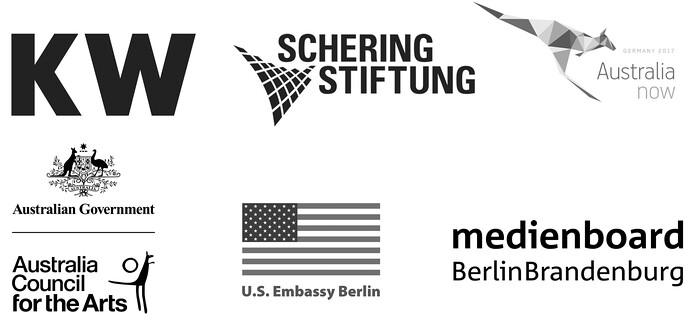Auguststraße 69
10117 Berlin
Germany
Hours: Wednesday–Monday 11am–7pm,
Thursday 11am–9pm
T +49 30 24345941
press@kw-berlin.de
Enemy of the Stars
Ronald Jones in dialogue with David Hammons, Louise Lawler, Helmar Lerski, and
Julia Scher
May 20–August 6, 2017
Hiwa K
Don’t Shrink Me to the Size of a Bullet
Schering Stiftung Art Award
June 2–August 13, 2017
Nicholas Mangan
Limits to Growth
June 2–August 13, 2017
Departing from an investigation into language as a driving force and political instrument in artistic practices the summer season at KW looks at the impact that politics have more specifically on objects, locations, and the infrastructures that shape our everyday life. Through a constellation of exhibitions the season probes the ideological systems that govern our existence and the complex and interrelated causes and effects that each decision has within these networks.
The season is spearheaded by the exhibition Enemy of the Stars, which reflects on Ronald Jones’ artistic and theoretical practice in regards to the current political climate. During the 1980s and 90s, Jones produced a body of work that sought to reveal the patterns of key political occurrences that shape our existence through drawing connections between parallel and seemingly unrelated events. Jones often drew on design and art historical references and placed them in conversation with historical incidents and socio cultural manifestations often with the aim to bridge abstraction, utility, and historical fact, questioning the relationship between style and aesthetics and a social political consciousness.
The exhibition Enemy of the Stars is curated by Jason Dodge and Krist Gruijthuijsen and aims to reflect and expand upon Jones’ practice by placing crucial work in close dialogue with peers at the time, such as David Hammons, Louise Lawler, and Julia Scher as well as with historical works from Helmar Lerski in order to open a critical dialogue on how political ideas relate to biography, text relates to form, and identity relates to the notion of the subject.
During the exhibition, a public program titled Addendum is presented with a series of commissions and adaptations, featuring works by Jenna Bliss, Sidsel Meineche Hansen, Ishion Hutchinson, and K.r.m. Mooney. Addendum is organized by Anna Gritz, Curator at KW.
Simultaneously, two ambitious solo exhibitions survey the work of Australian artist Nicholas Mangan and Iraqi-Kurdish artist Hiwa K—winner of the Schering Stiftung Art Award 2016.
Limits to Growth is the first survey exhibition by Nicholas Mangan and a unique introduction to the depth and variety of Mangan’s practice to European audiences. With a strong research base in both history and science, Mangan’s work addresses a range of themes, including the ongoing impacts of colonialism, humanity’s relationship with the natural environment, contemporary consumptive cultures, and the complex dynamics of the global political economy. At KW Mangan’s solo exhibition brings together five key projects produced over the last nine years in conversation with a new film production. The show lends its title from the work Limits to Growth (2016), which was produced for the touch and which explores the relationship between two monetary currencies: Rai, large stone coins from the Micronesian island of Yap, and Bitcoin, a digital currency allegedly invented by Satoshi Nakamoto in 2008. The survey exhibition was developed jointly by KW with Monash University Museum of Art in Melbourne (MUMA), and the Institute of Modern Art in Brisbane (IMA) and is accompanied by an extensive publication.
The exhibition Don’t Shrink me to the Size of a Bullet by artist Hiwa K presents a selection of works from the past ten years as well as an ambitious new production, coproduced by the Schering Stiftung with support of the Medienboard Berlin-Brandenburg. Forced to leave his home country for political reasons, the disconnection with what was formally known as “home” is crucial to the artistic inquiry undertaken by Hiwa K. This question drives the artist to produce work in which vernacular forms, oral histories, and political constructs are intertwined. The various references in his practice consist of stories told by family members and friends, found situations, and everyday encounters that evolve around make-shift solutions and pragmatic approaches to often complex ideas and concepts. In this capacity, the artist attempts to retain the traditions surrounding his upbringing while also obtaining the knowledge that will help him to further integrate into newer environments. The exhibition is accompanied by an extensive publication.
Alongside its exhibition program, KW is continuously pushing beyond the confines of the physical building through its commission program. These commissions are produced in order to present a different temporality and dedication to art production, in which the environment and architecture of both institutions—KW and the Berlin Biennale for Contemporary Art—is challenged. New additions for this season are by atelier le balto, Trevor Paglen, and Felix Gonzalez-Torres.
KW is also delighted to announce the KW Production Series, a new commissioning project dedicated to artists’ moving image. In collaboration with the Julia Stoschek Collection and Outset Germany, KW will concentrate on two new productions per year. The series is inaugurated with artists Jamie Crewe and Beatrice Gibson. The series is produced by Mason Leaver-Yap, KW’s Associate Curator.
Enemy of the Stars is generously supported by the KW Freunde e. V., U.S. Embassy Berlin, Pedro Barbosa, and Julia Stoschek Collection. The presentation of the work of Helmar Lerski is supported by Museum Folkwang, Essen (Germany). With a special thanks to Christine König and Christiane Rhein.
The exhibition Hiwa K: Don’t Shrink Me to the Size of a Bullet. Schering Stiftung Art Award is a collaboration between the Schering Stiftung and KW Institute for Contemporary Art, and is supported by Medienboard Berlin-Brandenburg.
The exhibition Nicholas Mangan: Limits to Growth is generously supported by the Australian Government as part of the cultural initiative Australia now Germany 2017. This project has been assisted by the Australian Government through the Australia Council, its arts funding and advisory body.
KW Institute for Contemporary Art is institutionally supported by the Senate Department for Culture and Europe.



